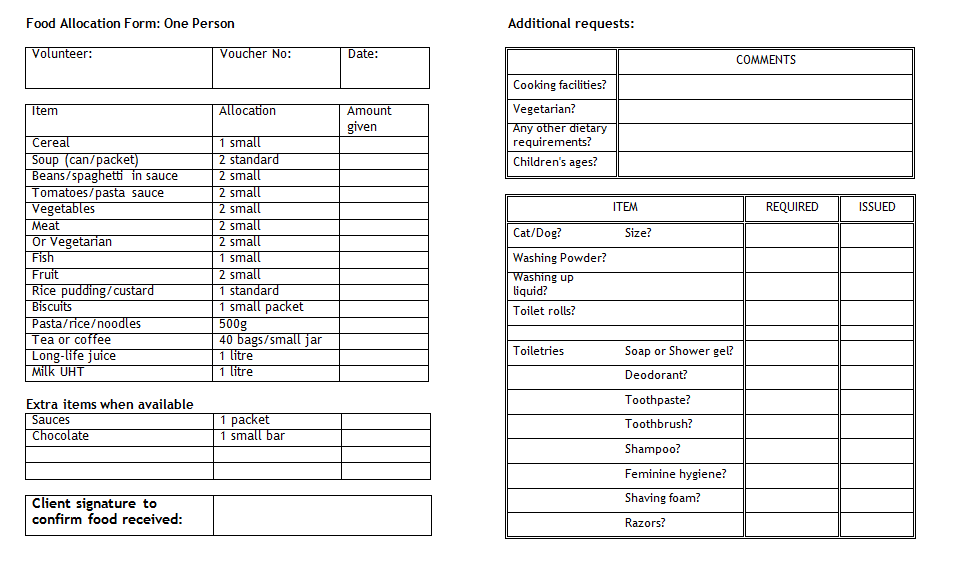Samantha Stapley, Director of Operations:
Foodbanks in our network use standard packing lists for each emergency food parcel that goes to someone in crisis. This is to ensure a balanced supply of food, whatever the household size, is provided to everyone referred – you can see an example of a list for a single person below.
This standard list is why you’ll often see foodbanks in our network asking publically for very different things – although there are some items that foodbanks often run low on across the board (UHT milk and coffee are good examples of these, whereas they’re all often very well stocked up on baked beans and tinned soup!), individual foodbanks often need different items to make up this balanced parcel. So it’s always best to check with your local foodbank about which items are most helpful if you’re thinking of making a donation – you can find your local foodbank’s contact details via our ‘Find a Foodbank’ map.
Nutrition guidelines change over time, so we are continually consulting with nutritionists to check our parcel still meets recommendations for emergency provision – on average, people come to a Trussell Trust foodbank twice in a year, so parcels really are for short-term use. You can read the latest report on our standard parcel here. Thank you so much to Dr Darren Hughes, Edwina Prayogo and Dr George Grimble at University College London for your work on this.
In line with the recommendations made, we’ve been putting some changes into practice: for example, removing 500g of sugar from standard parcels and suggesting to foodbanks in our network that it is instead placed on a ‘help yourself’ table, so if someone wants sugar for their tea or coffee, they can make that decision themselves – obviously a big part of not having enough money for food is having choice taken away from you entirely, so foodbanks in our network work hard to provide that element of choice for people.
That’s why foodbanks will also ask people about any preferences on flavours or items on the packing list, and if donations allow for it, changes will be made so that someone is taking home food they like. There’s no point giving someone tinned sardines if they only like tinned tuna! We know there’s always room for improvement so we’ll be looking at the other recommendations in the new report closely over the coming months to ensure our network’s standard parcel offer is as strong as it can be.
On top of the standard parcel, many foodbanks in our network do offer fresh food where they are able to safely – for example, fruit, vegetables, eggs and bread.
An array of fresh fruit being given out in Wavertree #foodbank session today thanks to @ComMutualInfo pic.twitter.com/eo9svDmSsk
— Imagine If Trust (@ImagineIfTrust) February 2, 2018
So pleased with our second @FareShareUK donation from @Tesco, Halfway, #WaltononThames. We ❤️ giving fresh food to our clients. Thank you! pic.twitter.com/wsCCoLpONg
— WaltonHershamFdbank (@WaltonHershamfb) December 21, 2017
Starting a new wee scheme here, fresh eggs!
— GlasgowNEfoodbank (@GlasgowNE) April 30, 2018
At the moment not every foodbank in our network can handle perishable food safely – the majority of our foodbank centres are based in churches in a ‘pop up’ way for a few hours, not built-for-purpose buildings – and the safety of people referred to us has to be our first priority. But we’re committed to providing the best possible service for people which is why we’re pleased our new partnership with Asda and FareShare will support foodbanks to offer more to people that come to them in crisis. One element of this partnership will be supporting more foodbanks to have the opportunity to safely offer fresh food alongside the standard parcel, helping with things like refrigeration and transporting perishable food.
Another key part is providing grant opportunities directly to foodbanks in our network, helping projects to access more training, volunteer resources, support and funding to provide not only emergency food to people but also wider support. Projects foodbanks run such a budget cookery courses and holiday clubs that provide fresh meals on the day, and help to build confidence and dignity, will be supported through this.
Tackling #holiday hunger with our #holidayclub. & look at the cake @kwesthotel made! @TrussellTrust @EndHunger_UK pic.twitter.com/bO4slG435g
— H&F Foodbank (@hffoodbank) April 3, 2018
Whilst all of this additional support will make a real difference to people at foodbanks in the immediate future, ultimately, the best thing is for people to have enough money to make their own choices about what to buy. That has to be our end goal. We want to see a future where there is no need for foodbanks.
This is why we’re determined to continue tackling the root causes of hunger in the long term. The final thing the partnership will fund is The State of Hunger, a three-year piece of landmark research into the drivers of foodbank use. We’ll be using the findings to campaign for systemic policy change on the structural issues that leave people facing hunger. We’ll never stop speaking truth to power – people may only come to a foodbank in our network twice in a year, but that is two times too many.




